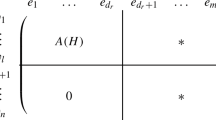Abstract
We study properties of binary codes with parameters close to the parameters of 1-perfect codes. An arbitrary binary (n = 2m − 3, 2n-m-1, 4) code C, i.e., a code with parameters of a triply-shortened extended Hamming code, is a cell of an equitable partition of the n-cube into six cells. An arbitrary binary (n = 2m − 4, 2n-m, 3) code D, i.e., a code with parameters of a triply-shortened Hamming code, is a cell of an equitable family (but not a partition) with six cells. As a corollary, the codes C and D are completely semiregular; i.e., the weight distribution of such codes depends only on the minimal and maximal codeword weights and the code parameters. Moreover, if D is self-complementary, then it is completely regular. As an intermediate result, we prove, in terms of distance distributions, a general criterion for a partition of the vertices of a graph (from rather general class of graphs, including the distance-regular graphs) to be equitable.
Similar content being viewed by others
References
Avgustinovich S.V., Vasil’eva A.Y.: Testing sets for 1-perfect code. In: Ahlswede R., Bäumer L., Cai N., Aydinian H., Blinovsky V., Deppe C., Mashurian H. (eds.) General Theory of Information Transfer and Combinatorics. Lecture Notes in Computer Science, vol. 4123, pp. 938–940. Springer, Heidelberg (2006). doi:10.1007/11889342_59.
Best M.R., Brouwer A.E.: The triply shortened binary Hamming code is optimal. Discret. Math. 17(3), 235–245 (1977). doi:10.1016/0012-365X(77)90158-3
Blackmore T.: Every binary \({(2^m - 2, 2^{2^m-2-m}, 3)}\) code can be lengthened to form a perfect code of length 2m − 1. IEEE Trans. Inform. Theory 45(2), 698–700 (1999). doi:10.1109/18.749014
Krotov D.S.: On the binary codes with parameters of doubly-shortened 1-perfect codes. Des. Codes Cryptogr. 57(2), 181–194 doi:10.1007/s10623-009-9360-5
Krotov D.S.: On weight distributions of perfect colorings and completely regular codes. Des. Codes Cryptogr. 61(3), 315–329 (2011). doi:10.1007/s10623-010-9479-4
Krotov D.S., Östergård P.R.J., Pottonen O.: On optimal binary one-error-correcting codes of lengths 2m − 4 and 2m − 3. IEEE Trans. Inform. Theory 57(10), 6771–6779 (2011). doi:10.1109/TIT.2011.2147758
Östergård P.R.J., Pottonen O.: Two optimal one-error-correcting codes of length 13 that are not doubly shortened perfect codes. Des. Codes Cryptogr. 59(1–3), 281–285 doi:10.1007/s10623-010-9450-4
Vasil’ev Y.L.: On nongroup close-packed codes. In: Problemy Kibernetiki, vol. 8, pp. 337–339 (1962). In Russian, English translation in Probleme der Kybernetik 8, 92–95 (1965)
Author information
Authors and Affiliations
Corresponding author
Additional information
Communicated by V. A. Zinoviev.
Rights and permissions
About this article
Cite this article
Krotov, D.S. On the binary codes with parameters of triply-shortened 1-perfect codes. Des. Codes Cryptogr. 64, 275–283 (2012). https://doi.org/10.1007/s10623-011-9574-1
Received:
Revised:
Accepted:
Published:
Issue Date:
DOI: https://doi.org/10.1007/s10623-011-9574-1
Keywords
- Coding theory
- Hamming code
- Extended code
- 1-perfect code
- Triply-shortened 1-perfect code
- Equitable partition
- Perfect coloring
- Weight distribution
- Distance distribution



